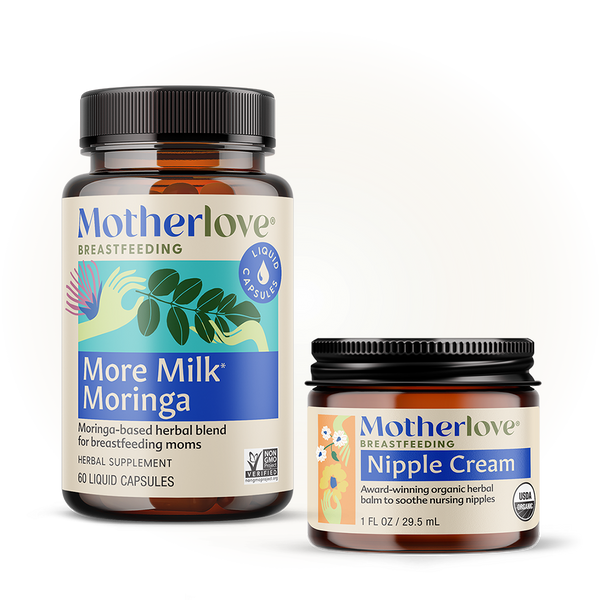Written by: Wendy, IBCLC
When you are pregnant and imagining what it will be like to breastfeed your baby, you might imagine a squishy baby snuggled up close to you contentedly feeding. And while this is likely to be your reality at some point in your breastfeeding journey, the first few days — as you and your baby are figuring out the breastfeeding thing for the first time — can be challenging.
While breastfeeding is one of the most natural things in the world, it doesn’t always come naturally for moms, especially at first. Breastfeeding for a brand new mom can look like awkward latching, uncertainty about whether their baby is getting enough milk, and tender nipples. Some of this is a normal part of the learning curve, and some of it warrants further help.
Either way, it’s important for new moms to have a sense of what to expect in those first few days of breastfeeding — what’s normal, what may not be normal, and when to get the support you need to smooth out the bumps in the road.
MOST COMMONLY ASKED QUESTIONS:
1. When Will My Milk Come In?
Many moms are concerned about when their milk will come in after giving birth. The truth is, though, that you actually have had some milk in your breasts since the middle of your pregnancy. Colostrum, a yellowish milk packed with immunities, is your baby’s first milk and provides all the nutrition your baby needs as your more mature milk comes in.
Your mature milk — which is much more abundant than colostrum — will likely start to come in about 2-5 days after birth. Moms who have c-sections may find that their milk comes in on the later part of that timeline.
Some moms have dramatic signs that their milk is coming in, such as very full or engorged breasts. For other moms, the signs are more subtle. But all moms will usually notice a fuller feeling in their breasts. They may also notice their babies gulping milk while nursing. Baby poop also transitions from the tarry, black meconium that is passed soon after birth, to a greenish “transitional” poop, and then to a yellowish looking poop when your milk is fully in.
If you don’t think your milk has come in by about five days after birth, you should consider consulting with a lactation consultant or other breastfeeding helper to explore whether anything needs to be addressed.
2. What Is Normal When It Comes To Baby Weight Gain?
It is normal for your baby to lose a little weight in the first few days after birth. This is partly because they pass their first poop (meconium) and partly because they lose some extra fluids after birth. Typically, babies can lose 7% to 10% of their birth weight without there being an issue.
Usually, if feeding is going well and your milk has come in, your baby will start to put on a few ounces by the end of their first week of life, and your baby should most definitely be gaining rather than losing weight by two weeks postpartum.
If you have any concerns about your baby’s weight gain, it’s better to address these issues sooner rather than later, so you can get things moving in the right direction and so that your baby is healthy and thriving.
3. How Much Nipple And Breast Pain Is Normal?
This is the million-dollar question. Some moms are told that a little nipple pain is normal in the early days of breastfeeding – others are told it’s never normal and is a problem.
The answer lies somewhere in the middle, though anytime you experience pain that is bothering you, especially if it is coupled with other breastfeeding concerns, you should feel free to address these with a lactation consultant or breastfeeding professional.
In general, the rule of thumb is that if you feel a little tugging or pulling at the beginning of a breastfeeding session, but the pain seems to go away soon after your baby starts suckling, it’s probably nothing to be concerned about. However, if the pain is strong, long-lasting — and if it causes any nipple damage, it’s something that should be addressed as soon as possible.
Bleeding nipples, cracked nipples, pinched nipples, and nipples that look like a tube of lipstick after they come out of your baby’s mouth could indicate a latching issue, and usually require some hands-on help or latching adjustments to fix. Keep in mind, though, that these sorts of problems are common and are almost always fixable with a little care and assistance.
4. What Is Normal Baby Behavior At The Breast?
Lots of new moms wonder if their baby’s behavior at the breast is normal, and if it might indicate a breastfeeding issue.
Here are some baby behaviors that are usually completely normal:
- Newborns sleep a lot — they are usually either sleeping or nursing, with a few moments here and there in a quiet alert state, where they may even look right into your eyes!
- Newborns nurse very frequently, sometimes every hour, and will need to nurse in the middle of the night.
- Newborns cry, but if they are fed frequently and held in someone’s arms often, they are less likely to cry.
- Newborns are likely to be a little fidgety before a nursing session — it’s good to bring them to the breast before they are starving or frantic — and tend to relax and fall asleep after nursing.
If your baby sleeps all the time and doesn’t wake up for feeding, or if your baby seems too upset to breastfeed — or if you have any questions about your baby’s behavior — reach out to your midwife, pediatrician, or breastfeeding professional.
5. What Is Normal - Vaginal vs. C-Section Births?
If you have had a Cesarean birth, you might be concerned about how breastfeeding will go for you. The good news is that while C-sections can sometimes make breastfeeding more complicated, it shouldn’t impact your experience too much, especially if you reach out for help with any issues you may be having.
Here are some things to know about C-sections and breastfeeding:
- Your milk may come in a little later if you’ve had a C-section, but it will come in eventually.
- It may be harder to find a breastfeeding position that works for you and doesn’t interfere with your healing incision. But using a position that keeps your baby off that area, such as a reclining position, or a football hold, can be helpful.
- Most pain medications C-section moms are provided will be compatible with breastfeeding; you can consult your doctor if you have any questions.
- C-section mamas might need extra help postpartum, with tasks such as lifting the baby and positioning them at your breast. Don’t be afraid to ask for help from loved ones and caretakers.
- For more tips on navigating breastfeeding after a Cesarean read our resource article here.
6. How Long Will It Take For Me To Get The Hang Of This?
The early days of breastfeeding and postpartum in general can feel like they last forever. If you have a breastfeeding challenge early on, it can be easy to feel defeated and to wonder if you will ever get the hang of things and if breastfeeding will become as easy as some moms make it look.
First of all, all moms — even the ones who seem to have it together when it comes to breastfeeding — have challenges in the early days. It's normal and can be common! You have to remember that you are learning how to do this — and your baby is too! Each day things will get a little easier for you. By one month or so postpartum, you should notice some improvements and that you and your baby are getting in “flow” together (pun intended!).
Most moms find that breastfeeding feels second nature by three months postpartum, if not sooner. But again — and I can’t stress this enough — if you have any questions or concerns whatsoever, it’s always best to reach out for help. No mom should do this alone.





